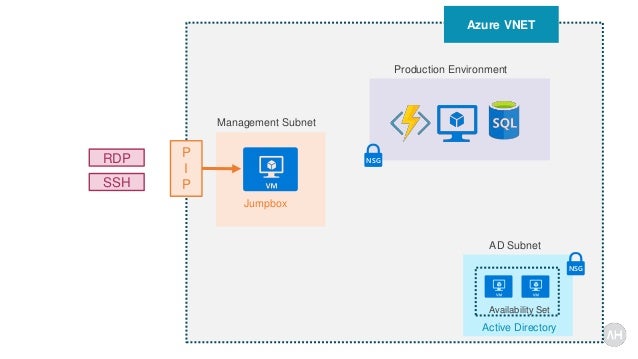
So in the remoting protocol vulnerability scenario, you are still vulnerable at the application layer. Unfortunately, it’s still straight RDP/SSH into a machine that is directly accessible on the Internet. You remote into a jumpbox, and from there, you remote into one of your application/data virtual machines. They are isolated into a dedicated subnet. This is an old method – a single virtual machine, or maybe a few of them, are made available for direct access. And the way JIT VM Access manages the rules now is wonky, so I would not trust it. So, if it’s all set up right, you deny remote access to virtual machines most of the time. When you need to remote onto a VM, an NSG rule is added for a managed amount of time to allow remote access via the selected protocol from a specific source IP address. It modifies your NSG rules to deny managed protocols such as RDP/SSH (the deny rules are stupidly made as low priority so they don’t override any allow rules!). JIT VM Access is a feature of Security Center Standard Tier.
#Azure bastion password#
If you have supported end user VPN then you know that it’s right up there with password resets for helpdesk ticket numbers, even with IT people like developers. The clue is in the maximum number of simultaneous connections which is 128, way too low to consider as an end user solution for a Fortune 1000, who Microsoft really do their planning for. The real reason that we have point-to-site VPN in Azure virtual network gateway was as an admin entry point to the virtual network. There are ways that you can secure things, but they all have the pluses and minuses. And if the recent scare about the RDP vulnerability didn’t wake you up to this, then maybe you deserve to have someone else’s bot farm or a bitcoin mine running in your network. If you enable Standard Tier Security Center, the alerts will let you know how bad pretty quickly. Just opening up RDP or SSH straight through a public IP address is bad – hopefully you have an NSG in place, but even that’s bad. Remember: for 99.9% of customers, servers are not cattle, they are sacred cows. You need RDP or SSH to be able to run these machines in the real world. Most people that are using The Cloud are using virtual machines, and one of the great challenges for them is secure remote access. In the right there is a new tab called “Configuration”.Microsoft has announced a new preview of a platform-based jumpbox called Azure Bastion for providing secure RDP or SSH connections to virtual machines running or hosted in Azure.


After the deployment process is finished go to the Azure Bastion blade in the Azure portal and select the newly deployed Bastion service.
#Azure bastion how to#
Only the Azure Portal allows to deploy an Azure Bastion Standard SKU with the host scalling feature, because the feature is in public preview.įirst deploy an Azure Bastion basic SKU, please take a look at my How to deploy article for best practices and guidelines. Please note that when using an Azure Bastion Standard SKU, the AzureBastionSubnet size should be increased to a subnet size of approximately /26 or larger. The Standard SKU allows you to specify the number of instances called as host scalling. In general when you deploy the Azure Bastion Basic SKU Microsoft deploys two instances which supports 20-24 concurrent sessions which means each instance support 10-12 sessions. This Azure VM is called a Instance and had some limitations. When you create an Azure Bastion instance Microsoft creates in the backend an optimized Azure VM that runs all the processes they are needed for Azure Bastion.


 0 kommentar(er)
0 kommentar(er)
